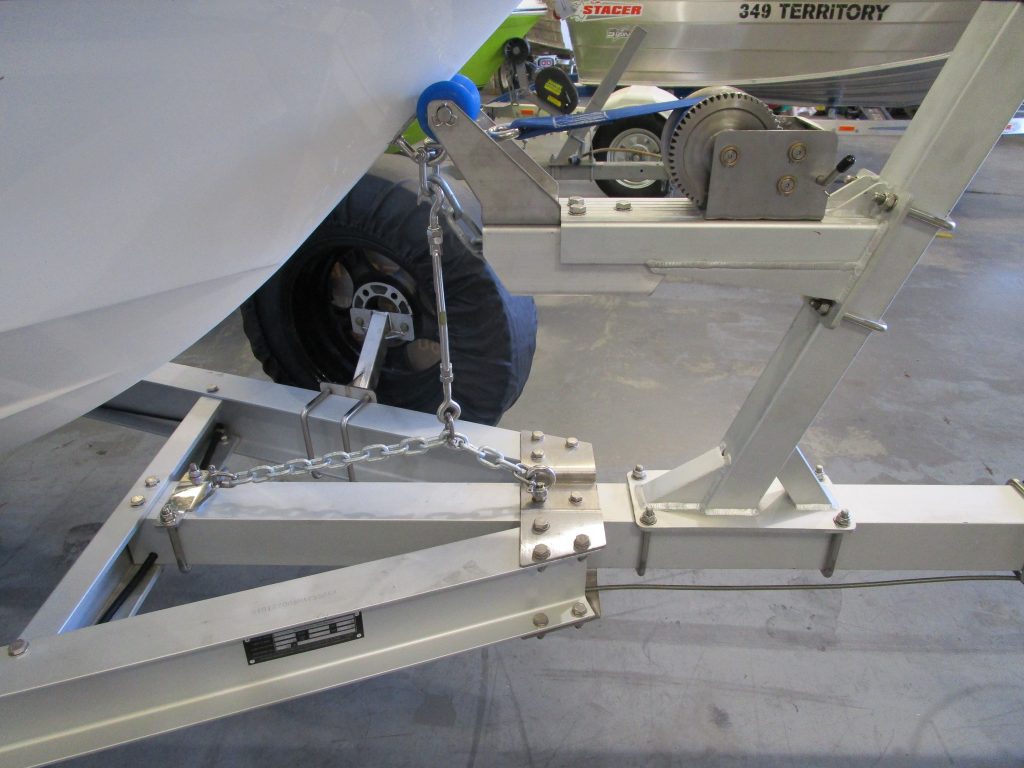Tie-downs
It’s nearly holiday time… and that means many people will be on the road with their boats in tow. And that also means it’s a good time review what we all need to consider when tying our boats to trailers.
Sounds simple – but we see many Tie-Down mistakes being made. When people ask us how we suggest it be done …we ask them to consider a number of factors as outlined below.
The main purpose of the Tie-Down is to restrain movement of the boat – although in many cases we see these restraints being incorrectly used to overcome trailer problems too.
In practical terms, the trailer is the vehicle, and the boat is the load. According to the National Transport Commission’s “Load Restraint Guide for Light Vehicles 2018”, there are 3 minimum forces that restraints must be capable of holding to deem the load safe, namely;
To restrain 80% of the weight of the load against forward motion
To restrain 50% of the weight of the load against side-ways and rear-wards motion
To restrain 20% of the weight of the load against upwards motion
These restraints are considered the minimum to ensure the load will not fall off or affect the stability of the trailer under normal driving conditions, including braking and minor collisions. If we assume an average 6m boat weight of 1.5ton… then this means your minimum restraint capability should be 1.2ton to oppose a forward force, 750kg to oppose backwards and sideways forces, and 300kg to restrain from upward movement.
What we see on many trailers are typically 3 restraints. One is the winch webbing (or rope), one is the winch safety chain, and one is a pair of rear transom (or over-hull) straps. Typically, the winch safety chain is slightly loose… and therefore in practical terms is not acting as a restraint until the boat is well and truly in motion in any direction.
How does this rate against the minimum recommendations and standards?
Forwards – we’re looking for 1.2ton – no restraint from rear transom straps, no restraint from the winch. The safety chain would need to be 10mm to 13mm thick to be considered a suitable load restraint – and not many trailers have this size safety chain at the winch.
Side-ways and rearwards – we’re looking for 750kg here. The transom straps could restrain rearwards and sideways if properly positioned… but would need to be rated at about 400kg each. At the bow the winch will restrain directly and with winch webbing usually at least 1.5 times the winch capacity – this restraint should be well over 1.5ton.
Upwards – we need 300kg. Rear straps would be effective at the rear. But at the bow the winch webbing is the primary restraint, perhaps together with the winch roller if setup in that way. However even at 25% of its capacity its restraining capacity will be within guidelines, not to mention the safety chain as backup.
Where to we fail the most? The forward restraint is the most common Tie-Down failure. And this is a big concern of boaties – not wanting the boat ending up in the trunk of the car!
Why is this such a big fail? Where do we go wrong? What about the winch post?
Most trailers are setup with the boat’s bow eye hard up against a large winch roller. We naturally assume from this that the winch post will stop the boat from moving forwards.
This is a massive mistake. Winch posts are designed to restrain the other way – it’s used to pull the boat onto the trailer while resisting a backwards force of the boat and its friction while being pulled onto the trailer. When you want the boat to go backwards… you release the winch! Boaties need to consider that a winch post is not designed to resist forward motion of any boat – even though countless people use it as such when driving onto their trailers. Winch posts should at least lean the other way (backwards) if they were remotely acting as forward motion restraints.
And further, if your winch post was designed as a restraint, then surely, just as webbing or chain is designed as a restraint and therefore needs to be rated and stamped, would you not expect to see a plate on the winch post certifying its capacity as a restraint? Have you ever seen a rated winch post? No – therefore do not depend on it as a forward restraint. In our example, how do we know our winch post is designed to restrain 1.2ton? Has it been tested? The answer is – we have no idea what forward force our winch post will resist!
A Tie-Down for any of the 3 forces must therefore be connected to the trailer chassis and the winch post is not part of the trailer chassis.


Caution:
In many cases we see boats tied down with chains and turnbuckles. And many times the turnbuckle is way-over tightened – often with the aid of a spanner or screwdriver. There is no need for restraints to be this tight and nor so restrictive. A chain and turnbuckle is a rigid structure and when over-tight, stress is quickly transferred to places that are not designed to relieve it. Damage will most likely occur after a period of time.

Our advice is to consider your boat and what you’re needing to restrain. And then select, position, and secure your Tie-Downs in the way that directly meets the function needed. In this way you will size and select Tie-owns correctly and you’ll also make sure they’re fastened where they’ll be properly utilised when needed.
Happy Boating
Andrew van Ryneveld
Spitfire Aluminium Boat Trailers




















